Home | City Notes | Restaurant Guide | Galleries | Site Map | Search | Contact

Judy Chan has invited me to lunch at Yank Sing restaurant for some straight talk about dim sum and the restaurant business. While the talk was straight by most standards, at times it turned fancy. What could you expect when talking about that wonderful Chinese lunch-food delicacy called dim sum?
Judy Chan is one of the driving forces behind the Yank Sing restaurants in the financial district of San Francisco. But she didn't start out in the restaurant business. Like a lot of us, she journeyed her way to a profession.
"I
went to UC Berkeley, got a degree in chemistry, then during my last year
of college I met my husband, whose family was in the  restaurant business."
restaurant business."
She was thinking of going to medical school but decided on pharmacy school to have more time for family life. She graduated but then when her mother-in-law died she found herself in the restaurant business helping her husband. Her husband was the only son in the family and felt obligated.
Hear the Chinese way of thought here? Careful consideration, wise decision making, family obligation? Almost the opposite of Western rashness and disregard for the family. The result? Success and strong family ties.
The original family business began in 1959 at a small place on Broadway and Powell. "It seated about 30 people," says Judy.
In 1974 Judy and her husband took a chance: They moved the restaurant to the financial district. "We were the very first ones. All the Dim Sum restaurants were in Chinatown."
Was their thinking becoming more Western? Perhaps. They were thinking smart anyway.
The location was in Stevenson alley between First and
Second Street.
Its still there, seating up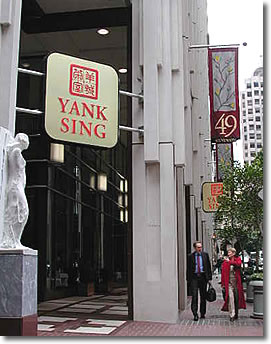 to
90 lunch goers every day. After that they opened another place in the
financial district, this time on Battery Street. But the building there
was torn down. No problem. They opened a new place in the Rincon Center
on Spear Street. Its huge, seats up to 248 people, but feels small, almost
cozy. How they have done this, I'm not sure. Carpets and soft colors—peaches
and creams—are
partly responsible.
to
90 lunch goers every day. After that they opened another place in the
financial district, this time on Battery Street. But the building there
was torn down. No problem. They opened a new place in the Rincon Center
on Spear Street. Its huge, seats up to 248 people, but feels small, almost
cozy. How they have done this, I'm not sure. Carpets and soft colors—peaches
and creams—are
partly responsible.
Now Judy and her husband have been joined in the business by their daughter, who took an almost direct path, went to Cornell University, studied restaurant management, then joined in the family business.
But enough family history. The success of the business is obvious. Try the food. The flavors are intense and satisfying. Look around the restaurant. It is spacious and beautiful. Experience the service. It is graceful and friendly. And nowhere did I see a smudge. In short, the old stereotypes of a Chinese restaurant are gone. If you miss that you will have to go to Chinatown and hunt down the bad service and the smudge in some hole-in-the wall place, 'cause you ain't going to find it here. (Truth to tell, sometimes I enjoy those hole-in-the-wall joints.)
But success does not happen all by itself.
The restaurant business in San Francisco is fascinating but says Judy, "You got to be really very detailed and look at everything. You have people problems. Food is a perishable item; you have to be sure it is fresh every day...."
She
snags a passing cart and asks if I like hot sauce. I say that I do and
she laddels some onto a small plate. We have three kinds 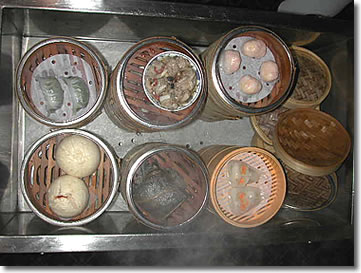 of jiaozi,
or dumplings, on the table. As I dip into the sauce with har
gow,
a shrimp dumpling, she suggests that I first try just a little. "It
is real spicy," she says. I am rash but reasonable. I dip carefully.
With the ice-cold vodka martini I am drinking, the sauce is not a problem.
of jiaozi,
or dumplings, on the table. As I dip into the sauce with har
gow,
a shrimp dumpling, she suggests that I first try just a little. "It
is real spicy," she says. I am rash but reasonable. I dip carefully.
With the ice-cold vodka martini I am drinking, the sauce is not a problem.
Now I am savoring the flavor of a lobster dumpling and listening. She says:
"Dim sum was an imperial cuisine. About a thousand years ago in China, the chefs, trying to please the emperor, instead of making big dishes, they made these little tiny dumplings; but they made it out of really exotic items—lark's tongue, pheasant ..."
When the Mongol invaded China, the court moved south, taking the cuisine with them and spreading it in the provinces. "But it was really in Canton," says Judy, "that this cuisine flourished because what happened was that some clever merchant or hawker decided, 'Oh, maybe I can make it out of very common items.'"
While it may not be made out of lark's tongue anymore,
it is anything but common these days. And while you can find fairly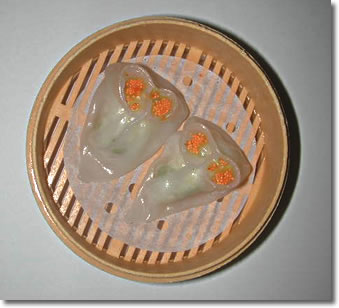 simple
dim sum—dumplings and pork buns in Chinatown at bargain prices—the
cuisine at Yank Sing runs more to the courtly tastes. The
lobster dumpling, for instance, is topped with a lovely layer of orange
roe.
simple
dim sum—dumplings and pork buns in Chinatown at bargain prices—the
cuisine at Yank Sing runs more to the courtly tastes. The
lobster dumpling, for instance, is topped with a lovely layer of orange
roe.
If you like martinis like I do, they go well with any dim sum item, though white wine is probably more sensible. Both will keep the palate clean and receptive to new flavors.
Dim sum is not for the lazy chef. It is labor intensive. "Dim sum actually means to touch the heart," says Judy. In order to get new ideas for dim sum, Judy travels; and recently she met a chef in China who told her, "It is made from the heart because every item, you really have to put your heart into it." The best dim sum is also a work of art.
Dim sum is also a competitive business. On her travels one chef told her, "Today I make this item, an hour later somebody else has already made it, and my boss is telling me, 'Did you copy him, or did he copy you?'"
Freshness
of ingredients is a factor too. Everybody likes to say
they
use fresh local ingredients, so I asked Judy how they do it. 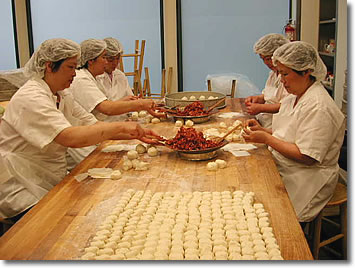 "In
California," she said, "your chances of getting good fresh
ingredients is very high. Number one, in terms of all the vegetables,
it's delivered every day." For the small shrimp that are used for
dim sum they get flash frozen ones, which she feels are fresher than
using live ones, which are usually used for large shrimp dishes. "All
vendors will guarantee the product. If it's not good, they ship us new
ones."
"In
California," she said, "your chances of getting good fresh
ingredients is very high. Number one, in terms of all the vegetables,
it's delivered every day." For the small shrimp that are used for
dim sum they get flash frozen ones, which she feels are fresher than
using live ones, which are usually used for large shrimp dishes. "All
vendors will guarantee the product. If it's not good, they ship us new
ones."
But Judy and her husband have brought more to their restaurants than just the food.
"In the past," she says, "Chinese restaurants have not
been known to be that concerned with other parts of the dining experience.
To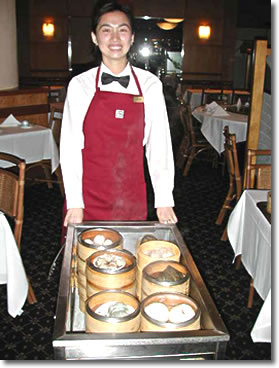 them, food, that was it." She and her husband have gotten involved
in the whole experience, from service to decor to cleanliness.
them, food, that was it." She and her husband have gotten involved
in the whole experience, from service to decor to cleanliness.
A cart quietly arrives on the carpeted floor and a young smiling waitress takes her time lifting the lids off baskets to show off the contents. Sometimes I have simple tastes. I choose barbequed pork buns, which I can eat any time of the day. These have a reddish and somewhat sweet filling that delights the taste buds. I feel for awhile like one of the old emperors eating lark's tongue.
Thanks you, Judy Chan, for the best dim sum this side of Shanghai. And cheers for a fine Ketel One! She didn't mention it, but the bar is an important part of a San Francisco restaurant too. Some say it is the only thing that matters. But I don't believe that anymore.
Home | City Notes | Restaurant Guide | Galleries | Site Map | Search | Contact